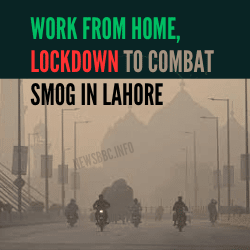-
- Lahore, Punjab: The Punjab government is actively considering a series of robust measures to address the escalating Lahore’s Smog Crisis in Lahore. These initiatives, reminiscent of the COVID-19 restrictions, are designed to combat the worsening air quality in the provincial capital effectively.
Potential Shutdowns and Workforce Adaptations
Insider sources have revealed that authorities are contemplating a complete shutdown on Wednesdays. This would involve the temporary closure of educational institutions, markets, and factories in the city for an entire day.
Furthermore, government departments may operate with only 50% of their regular workforce on Wednesdays. This reduction aims to significantly reduce vehicular activity and industrial emissions. Additionally, weekend inspections, particularly on Saturdays and Sundays, are under consideration to ensure strict compliance with air quality standards.
Identifying the Root Causes of Lahore’s Smog Crisis
It is crucial to recognize that the primary contributor to Lahore’s smog crisis is abnormal traffic conditions, which have greatly exacerbated the air quality problem. Surprisingly, emissions from factories, while not insignificant, constitute only 7% of the overall pollution in Lahore. This highlights the urgent need to address traffic congestion as a top priority in the fight against smog.
As part of the comprehensive strategy, sources indicate that factories found violating pollution regulations may face substantial fines. For those persistently ignoring these directives, the ultimate penalty could entail the suspension of their operations. This strict approach underscores the government’s commitment to holding industries accountable for their emissions and promoting eco-friendly practices.
Smog Peaks During the Early Week
According to sources, the highest levels of smog concentration tend to occur during the first three days of the week, from Monday to Wednesday. This concerning trend emphasizes the necessity of the proposed Wednesday shutdown and reduced workforce operations on that day.
Work-From-Home Initiative in Lahore’s Smog Crisis
In an effort to mitigate the smog crisis’s impact on Lahore, Commissioner Muhammad Ali Randhawa has announced plans for a two-month “work-from-home” policy within the Lahore Division. This initiative aims to reduce the daily influx of commuters, consequently decreasing vehicular emissions.
The announcement followed a meeting between Commissioner Randhawa, CCPO Bilal Siddiqui, and local traders to discuss the proposal of closing markets on Wednesdays. Notably, traders expressed their support for this initiative. Furthermore, the commissioner assured them that markets could remain open on Sundays if they wish to compensate for potential business losses.
Collaborative Efforts with Traders of Lahore’s Smog Crisis
Traders have actively engaged with the Lahore administration, providing valuable insights into tackling the smog crisis. One of their notable recommendations includes adjusting market operating hours to align with the government’s proposed schedule. The commissioner has emphasized that the final decision on market timings and closures will be made after extensive consultations with traders.
Impact of Air Pollution on Life Expectancy
The gravity of Lahore’s smog crisis is underscored by a recent report from the University of Chicago’s Energy Policy Institute (EPIC). This report, published in August, indicates that increasing air pollution in Pakistan, particularly in regions like Lahore, Sheikhupura, Kasur, and Peshawar, may lead to a significant reduction in life expectancy.
Understanding the Air Quality Life Index (AQLI)
The Air Quality Life Index (AQLI), a specialized pollution index, translates the effects of particulate air pollution into its direct impact on life expectancy. Shockingly, particulate pollution emerges as the second most significant threat to human health in Pakistan, following cardiovascular diseases. On average, it reduces life expectancy by a staggering 3.9 years.
Potential for Positive Change in Lahore’s Smog Crisis
The AQLI report offers hope by suggesting that adherence to the World Health Organization (WHO) guidelines, recommending an annual PM 2.5 concentration limit of 5 micrograms per cubic meter, could potentially restore 3.9 years of life expectancy to the average resident.
In contrast, child and maternal malnutrition, along with maternal and neonatal disorders, reduce average life expectancy by 2.7 years.
Widespread Pollution Levels of Lahore’s Smog Crisis
It’s essential to note that all 240 million people in Pakistan reside in areas where the annual average particulate pollution level surpasses the WHO guideline. Furthermore, a staggering 98.3% of the country’s population lives in areas exceeding its own national air quality standard of 15 micrograms per cubic meter.
Escalating Pollution Trends of Lahore’s Smog Crisis
The AQLI report also highlights a concerning trend. From 1998 to 2021, average annual particulate pollution levels in Pakistan surged by 49.9%. This increase in pollution levels translates to a tangible decrease in life expectancy—1.5 years, to be precise.
Regional Impact
In the provinces of Punjab, Islamabad, and Khyber Pakhtunkhwa—some of the most polluted regions in the country—an estimated 65.5 million residents, comprising 69.5% of Pakistan’s population, are projected to experience a significant reduction in life expectancy. They may face the loss of between 3.7 to 4.6 years of life expectancy on average compared to the WHO guideline. Furthermore, they could lose between 2.7 to 3.6 years relative to the national air quality standard if the existing pollution levels persist, as indicated by the AQLI report.
Also visit:The gold jewellery made from old phones
Hope for a Healthier Future
On a more optimistic note, the report emphasizes that should Pakistan meet the WHO’s guidelines, residents of Karachi could gain back 2.7 years of life expectancy. Similarly, residents of Lahore might enjoy a remarkable increase of 7.5 years, while people in Islamabad could anticipate a boost of approximately 4.5 years in their life expectancy.
Global Impact of Pollution in Lahore’s Smog Crisis
The report concludes by highlighting a broader perspective. It underscores that India is responsible for about 59% of the world’s increase in pollution since 2013. This emphasizes the regional and global nature of the air quality crisis, emphasizing the collective responsibility to address it effectively.
In summary, the Punjab government’s active consideration of comprehensive measures reflects a resolute commitment to addressing the ongoing smog crisis in Lahore. The proposed actions, including potential shutdowns, modified work patterns, and stricter regulations, aim to safeguard the health and well-being of the city’s residents. These initiatives respond to the alarming findings of the AQLI report, emphasizing the urgent need to combat air pollution in the region. Lahore, like many other global cities, stands at a crossroads where immediate action is essential to ensure a sustainable and healthier future for all.
Also visit:Ukraine War 16 Killed in Missile Attack on Market Town

